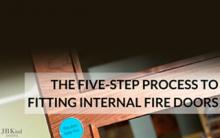The five-step process to fitting internal fire doors
The five-step process to fitting internal fire doors
Fitting internal fire doors is not like fitting an ordinary internal door. Not only is it imperative that certain processes are followed, but if they are not, it could literally put lives at risk! To ensure the safe fitting of your internal fire doors, follow the five-step process below:
1. Clarify your components
All doors are not compatible with all components, and all doors do not fit all door frames. Check the manufacturer’s instructions and fire certificate and make sure you have the right door furniture and frame to work with your fire door. If you don’t, it will invalidate any fire certification and you cannot guarantee the door will operate safely. You also need to make sure that all the components you use are CE marked (glazing and ironmongery) or accredited by a fire safety scheme like BWF-CERTIFIRE (door and frame), for example.
2. Check your fire certificate
If your fire door is really a fire door it will have certification to either BS476 pt22 or EN1634-1 and should ideally be covered by a third party accreditation schemes such as BWF-CERTIFIRE. If your fire door is not accredited, it cannot be considered a fire door so you should think again.
3. Check your supporting construction
Normally the wall (whether brick, block, masonry, timber or steel stud) should provide at least 30 minutes fire resistance.
4. Fitting the door into the frame
In order for your door to work well on a day to day basis it will need to have a consistent and equal gap around the door, usually advised by the manufacturer to be 3-4mm. To be accurate you will need to specifically measure the distance with a gap tester – available free from many sources, including BWF-CERTIFIRE.
When there is a fire however, it is important that there is no gap between the door and the frame for the fire or smoke to spread through. To achieve this, you need to fill this space with a fire stopping material, like intumescent strips or combined intumescent smoke seals, that will expand when it reacts with heat. This should make sure that fire will not get through any gaps into the rest of the building, for the duration of the fire door’s guarantee time e.g. FD30 equals 30 minutes, FD60 equals 60.
5. Closing the door effectively
The mechanism that you choose to close the door needs to be CE marked and BWF-CERTIFIRE (or other accrediting body) approved. It also needs to be the correct mechanism for the weight of the internal fire door so can it can open and close correctly, close in controlled way and onto a latch, or close onto door stop if there is not a latch.
So remember, the most important things to consider when you are fitting your internal fire door are to make sure:
- You have an accredited fire door together with CE marked and accredited door furniture (hinges, latches, screws etc) and mechanisms like closers.
- The door fits the door frame and there are appropriate gaps and either intumescent strips or intumescent smoke seals around the frame/door.
The door opens and closes properly, ensuring the door and door frame are positioned appropriately.
Published June 2017


